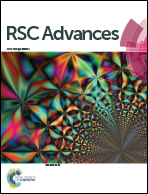Enzymatic synthesis and electrochemical characterization of sodium 1,2-naphthoquinone-4-sulfonate-doped PEDOT/MWCNT composite†
Abstract
The development of novel materials with improved functional characteristics for supercapacitor electrodes is of current concern and calls for elaboration of innovative approaches. We report on an eco-friendly enzymatic synthesis of a composite based on poly(3,4-ethylenedioxythiophene) (PEDOT) and multi-walled carbon nanotubes (MWCNTs). The redox active compound, sodium 1,2-naphthoquinone-4-sulfonate (NQS), was used as a dopant for the backbone of the polymer. Oxidative polymerization of 3,4-ethylenedioxythiophene (EDOT) was catalyzed by a high redox potential laccase from the fungus Trametes hirsuta. Atmospheric oxygen served as an oxidant. A uniform thin layer of NQS-doped PEDOT formed on the surface of MWCNTs as a result of the enzymatic polymerization. The PEDOT–NQS/MWCNT composite showed a high specific capacitance of ca. 575 F g−1 at a potential scan rate of 5 mV s−1 and an excellent cycling stability within a potential window between −0.5 and 1.0 V, which makes it a promising electrode material for high-performance supercapacitors.



 Please wait while we load your content...
Please wait while we load your content...